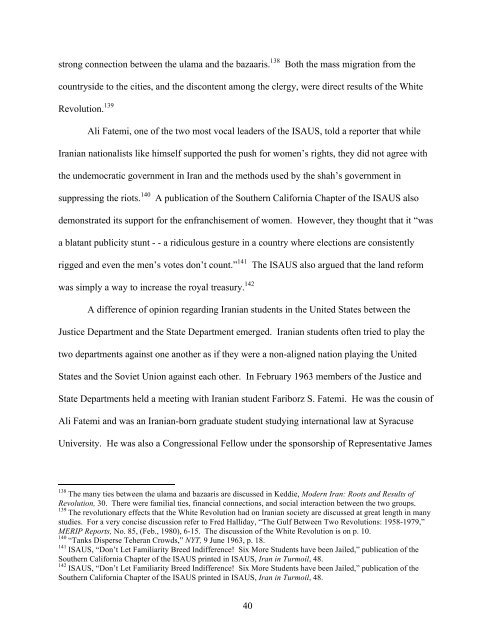AN AUGURY OF REVOLUTION: THE IRANIAN STUDENT ...
AN AUGURY OF REVOLUTION: THE IRANIAN STUDENT ...
AN AUGURY OF REVOLUTION: THE IRANIAN STUDENT ...
Create successful ePaper yourself
Turn your PDF publications into a flip-book with our unique Google optimized e-Paper software.
strong connection between the ulama and the bazaaris. 138 Both the mass migration from the<br />
countryside to the cities, and the discontent among the clergy, were direct results of the White<br />
Revolution. 139<br />
Ali Fatemi, one of the two most vocal leaders of the ISAUS, told a reporter that while<br />
Iranian nationalists like himself supported the push for women’s rights, they did not agree with<br />
the undemocratic government in Iran and the methods used by the shah’s government in<br />
suppressing the riots. 140 A publication of the Southern California Chapter of the ISAUS also<br />
demonstrated its support for the enfranchisement of women. However, they thought that it “was<br />
a blatant publicity stunt - - a ridiculous gesture in a country where elections are consistently<br />
rigged and even the men’s votes don’t count.” 141 The ISAUS also argued that the land reform<br />
was simply a way to increase the royal treasury. 142<br />
A difference of opinion regarding Iranian students in the United States between the<br />
Justice Department and the State Department emerged. Iranian students often tried to play the<br />
two departments against one another as if they were a non-aligned nation playing the United<br />
States and the Soviet Union against each other. In February 1963 members of the Justice and<br />
State Departments held a meeting with Iranian student Fariborz S. Fatemi. He was the cousin of<br />
Ali Fatemi and was an Iranian-born graduate student studying international law at Syracuse<br />
University. He was also a Congressional Fellow under the sponsorship of Representative James<br />
138 The many ties between the ulama and bazaaris are discussed in Keddie, Modern Iran: Roots and Results of<br />
Revolution, 30. There were familial ties, financial connections, and social interaction between the two groups.<br />
139 The revolutionary effects that the White Revolution had on Iranian society are discussed at great length in many<br />
studies. For a very concise discussion refer to Fred Halliday, “The Gulf Between Two Revolutions: 1958-1979,”<br />
MERIP Reports, No. 85, (Feb., 1980), 6-15. The discussion of the White Revolution is on p. 10.<br />
140 “Tanks Disperse Teheran Crowds,” NYT, 9 June 1963, p. 18.<br />
141 ISAUS, “Don’t Let Familiarity Breed Indifference! Six More Students have been Jailed,” publication of the<br />
Southern California Chapter of the ISAUS printed in ISAUS, Iran in Turmoil, 48.<br />
142 ISAUS, “Don’t Let Familiarity Breed Indifference! Six More Students have been Jailed,” publication of the<br />
Southern California Chapter of the ISAUS printed in ISAUS, Iran in Turmoil, 48.<br />
40















